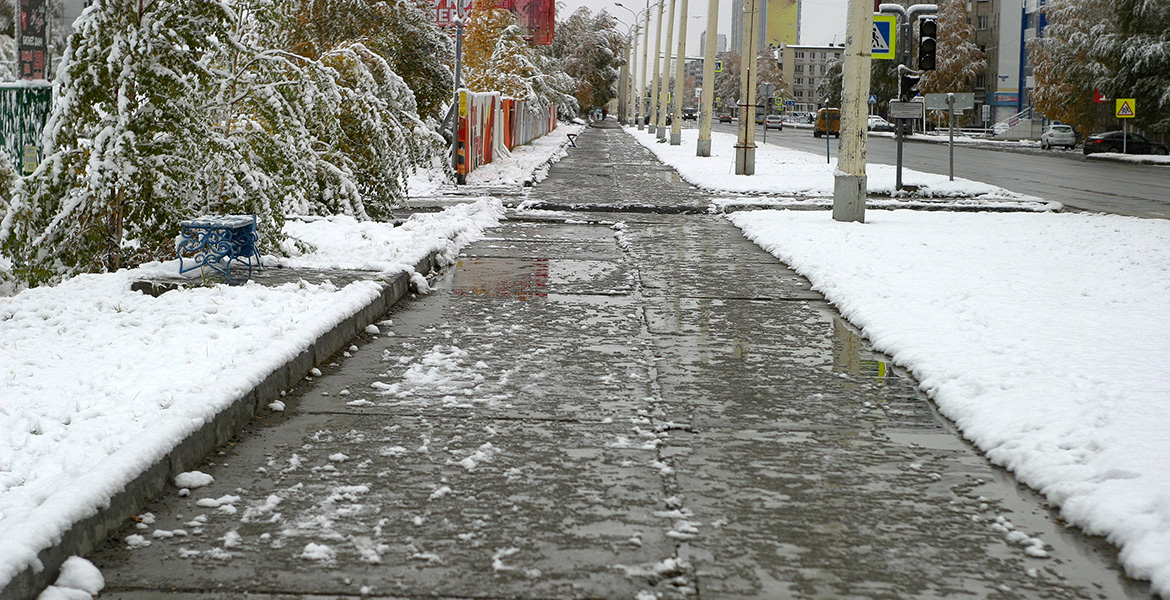
Deicing methods can be harmful to plants and hardscapes
Thursday, December 5, 2019
Oklahoma is no stranger to cold and ice. When the temperature drops and leaves a layer of ice on everything, getting from one place to the next can pose a hazard. This is the time of year when public safety is a high priority.
In order for roads and sidewalks to be safe for motorists and pedestrians, the use of deicing compounds is a must. While these deicing compounds make it safer for us, they often damage concrete surfaces, automobiles and landscape plants, said David Hillock, Oklahoma State University Cooperative Extension consumer horticulturist.
“Deicing materials are salts that melt ice, creating saltwater, which freezes at lower temperatures. The problem in the landscape occurs when this saltwater solution is splashed onto plant foliage or runs off pavement into the soil,” Hillock said. “An accumulation in the soil near plant roots results in damage to the plants. Plants suffer a salt induced water shortage, even though there may be moisture in the soil, because roots are unable to absorb sufficient water.”
There are several deicing compounds available, each with a set of pros and cons. Sodium chloride, also known as table or rock salt, is the most common. It is the least expensive, most widely used and is most effective when temperatures are above 15 degrees Fahrenheit. Unfortunately, sodium chloride is very corrosive and damaging to landscape plants and excessive sodium in the soil can destroy its structure.
Hillock said calcium chloride dissolves readily, acts quickly and is effective in very cold temperatures - down to -20 degrees Fahrenheit. It is, however, highly corrosive to concrete and metals, but slightly less damaging to plants than sodium chloride.
Potassium chloride is a natural material used for fertilizer, but is highly corrosive as a deicer. It is less damaging than sodium chloride to plants.
Calcium magnesium acetate is an environmentally friendly compound derived from dolomitic limestone and acetic acid. It’s considered safer for plant material, noncorrosive to concrete surfaces and it’s biodegradable. In addition, it’s effective at melting ice to around 15 degrees Fahrenheit. The downside, it’s 30 to 40 times more expensive.
“To minimize damage caused by deicing materials in the landscape, consider a few different approaches. First, mechanical removal of ice and snow. The less ice and snow present, the less deicing material is needed,” he said. “Try using abrasive materials in conjunction with mechanical methods and/or deicing materials. Abrasives such as sand has few impacts on the environment. While sand doesn’t melt ice, it does improve traction on slippery surfaces. Finally, plan ahead. Plant salt tolerant plants in areas that will receive deicing material. Locate your salt sensitive plants away from areas where deicing material will be used.”
He also pointed out homeowners can use hardscapes, including gutters and barriers, to channel runoff away from planting areas. Do not pile snow containing deicing materials onto planting areas.
“Finally, irrigate once heavily in the spring to leach salts away from the root zone. Obviously, we all want to be very careful with icy surfaces in the landscape, but keep in mind the wellbeing of your landscape plants,” Hillock said.
MEDIA CONTACT: Trisha Gedon | Agricultural Communications Services | 405-744-3625 | trisha.gedon@okstate.edu
